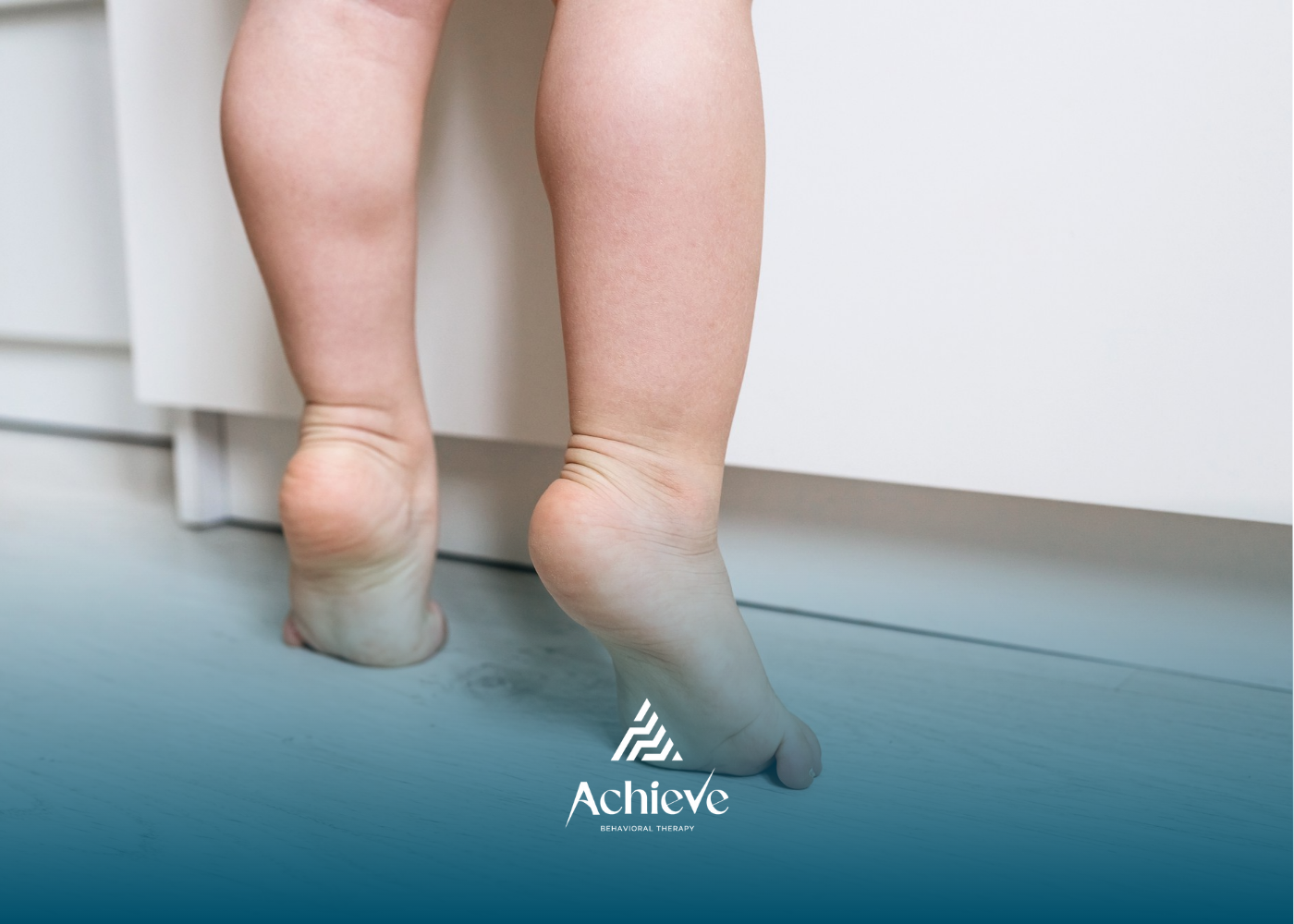Autism Toe Walking: Causes, Risks, and Solutions

Key Highlights:
- Toe walking is common in children with autism and may have multiple causes.
- It can result from sensory sensitivities, muscle tightness, or developmental differences.
- Persistent toe walking may lead to physical complications if not addressed.
- Interventions may include physical therapy, sensory strategies, and behavioral techniques.
- Early detection and consistent support can improve walking patterns and overall mobility.
Toe walking, or walking on the balls of the feet without heel contact, is a behavior observed in many children, including those with autism spectrum disorder (ASD). While occasional toe walking is typical in toddlers learning to walk, persistent toe walking beyond age two or three may indicate underlying medical, sensory, or developmental issues.
For children with autism, toe walking is relatively common, often linked to sensory processing differences, motor planning challenges, or behavioral patterns. Understanding the causes, risks, and intervention strategies is essential for parents, caregivers, and therapists to support a child’s mobility, posture, and overall development.
This article explores autism toe walking in depth, its potential causes, effects on physical development, and strategies—including therapeutic approaches—to help children improve their gait.
What Is Toe Walking?
Toe walking is defined as walking on the balls of the feet with little or no heel contact with the ground. It can occur intermittently or persistently. There are two main types:
- Idiopathic Toe Walking: Occurs without a known medical cause; common in children with autism.
- Pathological Toe Walking: Linked to medical conditions such as cerebral palsy, muscular dystrophy, or tight Achilles tendons.
Persistent toe walking can affect balance, posture, and lower limb development, making early recognition and intervention important.
How Common Is Toe Walking in Children with Autism?
Research suggests that toe walking is more frequent in children with autism than in neurotypical children. Estimates indicate that approximately 20-40% of children with autism exhibit some degree of persistent toe walking, compared to 5% in the general population.
The behavior may be:
- Intermittent: occurring occasionally during walking or running.
- Persistent: present consistently, even when the child is conscious of their gait.
Causes of Toe Walking in Autism
Toe walking in children with autism can arise from multiple factors:
1. Sensory Processing Differences
Many children with autism experience heightened or diminished sensitivity to sensory stimuli. Toe walking may provide:
- Proprioceptive input: Pressure on the balls of the feet can give feedback about body position.
- Vestibular stimulation: Toe walking may offer a sense of movement and balance.
2. Muscle Tightness
- Tightness in the Achilles tendon or calf muscles can make heel contact uncomfortable.
- Some children develop toe walking as a habitual posture due to muscle imbalances.
3. Motor Planning and Coordination Challenges
- Difficulties with gross motor skills or balance may contribute to toe walking.
- Children may find it easier to walk on their toes to maintain stability or avoid falls.
4. Behavioral Patterns
- Toe walking can become a repetitive behavior linked to autism’s restricted or repetitive behaviors.
- Some children continue toe walking simply out of habit or sensory preference.
5. Underlying Medical Conditions (Less Common)
- Cerebral palsy
- Muscular dystrophy
- Neurological disorders affecting motor control
Signs and Risks of Persistent Toe Walking
While some toe walking is harmless, persistent toe walking can lead to complications over time:
Physical Risks
- Shortened Achilles tendon
- Tight calf muscles
- Ankle stiffness or reduced range of motion
- Poor balance or coordination
Developmental Considerations
- Abnormal gait patterns may affect gross motor development.
- Toe walking can interfere with participation in sports or physical activities.
Behavioral Impact
- Children may become frustrated if they are asked to alter their walking pattern.
- Sensory discomfort may increase if the child is forced to walk in heels.
Assessing Toe Walking in Children with Autism
Evaluation typically involves multiple professionals, including pediatricians, physical therapists, occupational therapists, and sometimes orthopedists. Key assessment areas include:
- Observation of gait patterns during walking and running
- Muscle flexibility and strength testing
- Sensory processing evaluation
- Postural and balance assessment
- Medical tests to rule out neurological or orthopedic conditions
Strategies and Interventions for Toe Walking
Addressing toe walking in children with autism often involves a combination of therapies, exercises, and environmental adaptations.
1. Physical Therapy
- Stretching exercises to lengthen tight Achilles tendons and calf muscles
- Strengthening exercises for lower leg muscles
- Gait training to encourage heel-to-toe walking
- Balance and coordination activities
2. Occupational Therapy
- Sensory integration techniques to address proprioceptive or vestibular needs
- Tactile activities to improve foot awareness
- Gradual desensitization to heel contact if hypersensitivity is present
3. Behavioral Techniques (ABA)
- Positive reinforcement for heel-to-toe walking
- Step-by-step task analysis for walking correctly
- Visual supports or charts to encourage desired gait patterns
- Consistent reinforcement and tracking progress
4. Orthopedic Supports
- Stretching splints or braces in severe cases to encourage proper foot positioning
- Proper footwear with supportive soles to reduce discomfort
5. Home and Environmental Strategies
- Encourage barefoot walking on safe, varied surfaces to enhance proprioceptive input
- Use games and activities that motivate heel-to-toe movement
- Maintain consistent practice without forcing the child, which may create anxiety
Toe Walking Intervention Overview
| Strategy | Purpose | Practical Tips |
|---|---|---|
| Physical therapy | Stretch & strengthen muscles | Daily calf stretches, heel-to-toe exercises |
| Occupational therapy | Address sensory needs | Foot massage, balance boards, tactile floor activities |
| ABA techniques | Promote desired behavior | Reward heel contact, use visual cues |
| Orthopedic supports | Prevent muscle shortening | Night splints, supportive shoes |
| Home practice | Reinforce therapy | Barefoot activities, playful gait games |
When to Seek Professional Help
Parents should consult a professional if:
- Toe walking persists beyond age 3
- The child experiences pain, frequent falls, or a limited range of motion
- There are concerns about neurological or orthopedic conditions
- The child has difficulty participating in physical activities
Early intervention improves outcomes and can prevent long-term complications, making a multidisciplinary approach ideal.
Supporting Emotional and Behavioral Well-Being
Children with autism may resist changes to walking patterns due to sensory preferences or anxiety. Strategies for emotional support include:
- Using visual schedules and social stories to explain exercises
- Avoiding punishment or negative feedback for toe walking
- Celebrating small successes and incremental progress
- Incorporating movement exercises into play to make therapy enjoyable
Long-Term Outlook
With consistent intervention, most children with autism can improve their walking patterns. Some children may continue to toe walk occasionally, but targeted physical, occupational, and behavioral therapy can:
- Improve gait mechanics
- Prevent muscle shortening and joint issues
- Enhance participation in physical activities
- Reduce frustration or discomfort
Combining therapy approaches ensures children receive both the physical and sensory support they need to succeed.
Final Thoughts
Toe walking is a common behavior in children with autism, often linked to sensory sensitivities, motor challenges, muscle tightness, or behavioral patterns. While occasional toe walking may be harmless, persistent toe walking can affect muscle development, balance, and participation in physical activities.
Early evaluation and intervention—through physical therapy, occupational therapy, ABA techniques, orthopedic supports, and home strategies—can improve gait and overall mobility. A multidisciplinary approach, tailored to the child’s sensory and developmental needs, is key to supporting long-term success.
Achieve Behavioral Therapy offers specialized ABA therapy and individualized support for children with autism, helping families address challenges like toe walking while promoting developmental growth, mobility, and independence. Contact us today!
Frequently Asked Questions
Is toe walking normal in children with autism?
Yes, toe walking is common in children with autism. While occasional toe walking is typical in toddlers, persistent toe walking beyond age 3 should be evaluated.
Can therapy help a child stop toe walking?
Yes, a combination of physical therapy, occupational therapy, and ABA techniques can significantly improve walking patterns over time.
What are the risks of untreated toe walking?
Untreated toe walking may lead to muscle tightness, shortened Achilles tendons, joint stiffness, and balance issues.
Are sensory issues the main cause of toe walking in autism?
Sensory differences are a major factor, but toe walking may also result from muscle tightness, motor challenges, behavioral habits, or underlying medical conditions.
When should I consult a doctor about toe walking?
Seek professional guidance if toe walking persists beyond age 3, causes pain, limits mobility, or is accompanied by other developmental concerns.
Sources:
- https://autism.org/toe-walking-and-asd/
- https://pmc.ncbi.nlm.nih.gov/articles/PMC12387827/
- https://www.sciencedirect.com/topics/medicine-and-dentistry/vestibular-stimulation
- https://neurodivergentinsights.com/proprioception-inputs/
- https://pmc.ncbi.nlm.nih.gov/articles/PMC9600566/
Need Support?
We're Here to Help!
Our experienced team is ready to assist you. Reach out today to discuss how we can support your child's development and well-being.
Get started with expert ABA therapy today.














